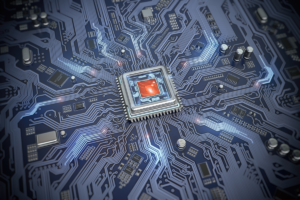Quantum computing is the holy grail for performing massive number crunching. A Canadian firm, D-Wave Systems, has unveiled what The Economist calls the “world’s first practical quantum computer” [“Orion’s Belter,” 17 February 2007]. The article explains why developing quantum computers is so important.
“On paper at least, quantum computers promise to reduce dramatically the time needed to solve a range of mathematical tasks known as NP-complete problems. One famous example is the travelling salesman problem—finding the shortest route between several cities. This is a puzzle that increases exponentially in complexity with the number of cities considered. The reason is that every possible permutation needs to be looked at in order to find the best. Quantum computers provide a neat shortcut to solving such problems. They do so by encoding all possible permutations in the form of a small number of “qubits”. In a normal computer, bits of digital information are either 0 or 1. In a quantum computer these normal bits are replaced by a “superposition” (the qubit) of both 0 and 1 that is unique to the ambiguous world of quantum mechanics. Qubits have already been created in the laboratory using photons (the particles of which light is composed), ions and certain sorts of atomic nuclei. By a process known as entanglement, two qubits can encode four different values simultaneously (00, 01, 10 and 11). Four qubits can represent 16 values, and so on. That means huge calculations can be done using a manageable number of qubits. In principle, by putting a set of entangled qubits into a suitably tuned magnetic field, the optimal solution to a given NP-complete problem can be found in one shot.”
To demonstrate that its quantum computer (named Orion) really works, D-Wave Systems selected two practical problems to demonstrate its 16-qubit processor reliability. One problem involved pattern-matching (in this case matching molecules, which is important in pharmaceutical research) and the other a scheduling problem that required the computer to assign people to seats based on certain criteria (a problem of interest to the airline industry). It doesn’t take much imagination to see how valuable pattern matching programs could be in a number of different sectors — including the intelligence sector. Solving those problems demonstrated that the computer had practical application, but that is where applying the term “practical” to Orion ends.
“Orion is not exactly desktop friendly. It has to sit in a bath of liquid helium cooled to just a fraction of a degree above absolute zero (-273°C) in order to work. This is because it relies on a superconducting device called a Josephson junction to produce the qubits, in the form of specially tweaked electrons that are stable only at such low temperatures. Impractical as this may sound, Geordie Rose, D-Wave’s founder, is optimistic that it is the best way forward for quantum computing. … Shrink-wrapped quantum computers labelled “Orion inside” are not, therefore, about to start shipping anytime soon. Quantum computing will be strictly mainframe for the foreseeable future. Nevertheless Dr Rose plans later this year to provide free, remote access to an Orion processor so that potential customers can try running their problems on it and evaluate its performance.”
The article goes on to note that there are other approaches as well:
“Other techniques involve huge lumps of machinery, but Josephson junctions can be made using the sort of microfabrication technology employed for normal silicon chips. This means there is a realistic prospect of integrating quantum computers with conventional ones. Dr Rose favours this route, because he sees quantum computers as specialised accelerators for certain tasks, rather than stand-alone number crunchers.”
The article notes that D-Wave Systems hopes that its breakthrough will help Canada develop its own West Coast silicon valley. Ironically, however, the company went to California to demonstrate its computer’s potential. To find out whether D-Wave Systems’ ambitions will be fulfilled, The Economist recommends you “come back in half a century.”




